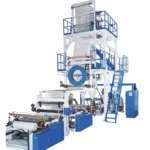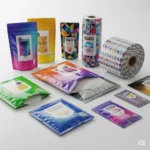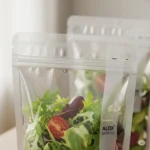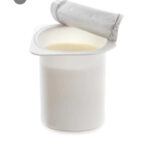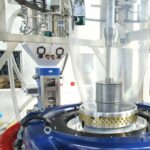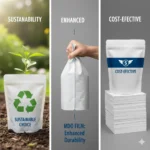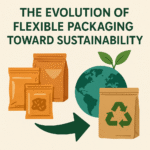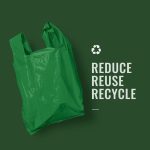As global environmental concerns intensify, industries are facing increasing pressure to adopt greener, more responsible practices. Packaging, in particular, has come under scrutiny, with single-use plastics often blamed for pollution and landfill overflow. In this landscape, flexible packaging—long valued for its efficiency and cost-effectiveness—is undergoing a major transformation to meet the demands of a more sustainable future.
This blog explores how flexible packaging is evolving through the use of recyclable materials, biodegradable films, compostable solutions, and its integration into the circular economy.
♻️ Recyclable Materials: A Step Toward Closing the Loop
Historically, flexible packaging has been difficult to recycle because of its multi-layer structure made from a mix of materials like plastic, foil, and paper. These combinations often make it incompatible with conventional recycling systems. However, the industry is now moving toward mono-material solutions that are easier to recycle. Like PE/PE, BOPP/BOPP structure etc.
Key Developments in Recyclable Flexible Packaging:
Mono-material films: Made entirely from polyethylene (PE) or polypropylene (PP), these films offer similar performance while being more easily recyclable.
Clear labeling: Brands are now including standardized recycling symbols to educate consumers about proper disposal.
In-store take-back programs: Some retailers offer collection bins for flexible plastic packaging, encouraging consumer participation in recycling.
The shift toward recyclable materials not only reduces waste but also helps brands align with Extended Producer Responsibility (EPR) regulations being introduced in many countries.
Biodegradable Films: Reducing Long-Term Environmental Impact
When recyclable infrastructure isn’t available, biodegradable packaging can provide an alternative route to reduce environmental harm. These materials are designed to break down naturally through microbial activity under specific conditions.
Common Biodegradable Materials Used:
PLA (Polylactic Acid): Derived from renewable sources like corn starch or sugarcane, it’s compostable and biodegradable under industrial conditions.
PHA (Polyhydroxyalkanoates): Created through bacterial fermentation of sugars and oils, offering excellent biodegradability even in marine environments.
Cellulose-based films: Sourced from wood pulp or cotton, these are naturally biodegradable and often used for dry food or hygiene products.
While promising, biodegradable films need the right conditions to decompose, which aren’t always available in landfill or natural environments. Still, they serve as a valuable solution in controlled settings like industrial composting facilities.
Compostable Packaging: Supporting Organic Waste Cycles
Closely related to biodegradable materials, compostable packaging is designed to fully break down into natural components—carbon dioxide, water, and biomass—within a specific timeframe, without leaving behind toxic residue.
Benefits of Compostable Packaging:
Reduces landfill burden: By allowing packaging to be processed along with organic waste.
Lowers carbon footprint: Derived from plant-based sources with a shorter lifecycle.
Promotes soil health: When fully composted, it can contribute to nutrient-rich compost.
Standards such as EN 13432 (Europe) and ASTM D6400 (U.S.) help verify whether a packaging product is truly compostable. However, consumer confusion and lack of composting infrastructure remain hurdles. Clear education and policy support are crucial to scaling compostable packaging successfully.
Flexible Packaging and the Circular Economy
Sustainability isn’t just about switching materials—it’s about rethinking the entire lifecycle of packaging. The circular economy model focuses on designing out waste, keeping products in use, and regenerating natural systems. Flexible packaging is increasingly being designed to fit within this regenerative model.
How Flexible Packaging Supports the Circular Economy:
Design for recyclability: Packaging is created with end-of-life reuse in mind.
Use of recycled content: Integrating post-consumer recycled (PCR) materials into new packaging to reduce raw material use.
Resource efficiency: Flexible formats typically use fewer materials than rigid alternatives, cutting energy use and transportation emissions.
Take-back initiatives: Brands are experimenting with collection and refill programs for pouches and sachets.
By adopting circular design principles, flexible packaging moves from being part of the waste problem to part of the sustainability solution.
Industry Innovations and Brand Examples
Many global brands and startups are leading the charge in sustainable flexible packaging.
Nestlé has committed to making all of its packaging recyclable, mono material or reusable by 2025. Nestle is also moving towards MDO film which is pe grade is easy recyclable with good barrier properties and excellent tensile strength.
Unilever is developing fully recyclable mono-material sachets and exploring refill pouches with spout & zipper.
Notpla, a UK-based company, has developed seaweed-based flexible film that is both edible and home-compostable.
These innovations demonstrate that sustainability and performance can go hand-in-hand, paving the way for widespread adoption.
Consumer Education: A Critical Piece of the Puzzle
Sustainable packaging can only succeed if consumers know how to dispose of it correctly. Mislabeling, misinformation, and the lack of easy disposal options often lead to even the most eco-friendly materials ending up in landfills.
Best Practices for Brands:
Include clear disposal instructions on the packaging
Use QR codes to link consumers to local recycling or composting guidelines.
Partner with NGOs and governments to support waste management education.
Empowering consumers with knowledge and tools will significantly improve the impact of sustainable packaging initiatives.
Innovation & development in flexible packaging.
- Mostly flexible packaging industry shift towards mono material laminate.
- Mostly top packaging industry are developing MDO films.
- Mostly packaging industry shift towards easy recyclable materials.
✅ Conclusion: A Greener Path Forward
Flexible packaging is no longer just about convenience, cost, and shelf life. It’s becoming a key player in the movement toward a sustainable, circular economy. Through the use of recyclable, biodegradable, and compostable materials, and by embracing circular design principles, the industry is making meaningful strides to reduce environmental harm.
However, the journey doesn’t end here. Continued innovation, infrastructure development, and consumer education are essential for truly sustainable outcomes.
As businesses and consumers work together, flexible packaging can evolve into a powerful symbol of responsibility and resilience — proving that sustainability and smart packaging can coexist.

